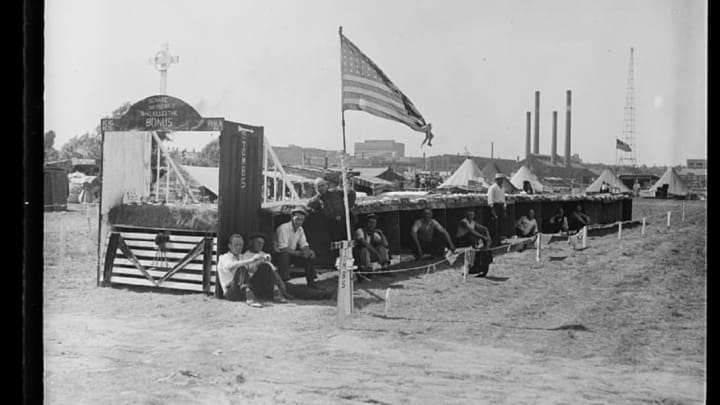1932: U.S. Army Kicks U.S. Veterans Out of Washington

In 1932, thousands of American veterans suffering from the poverty and unemployment of the Great Depression descended on Washington, D.C. to demand compensation for their service in World War I. Their two-month demonstration did not end peacefully.
Office of the Surgeon General, United States Army via Wikimedia Commons // Public Domain
Pensions, benefits, and bonuses had been offered to soldiers since the American Revolutionary War, but these promised benefits weren’t always promptly paid (or paid at all). For example, for some fighters in the Revolutionary War, it took 50 years after America won its independence for the government to pay their claims. Union veterans of the Civil War had to wait decades for benefits, and Confederate veterans were at the mercy of bankrupt states. No bonuses were paid for veterans of the Spanish-American War.
SteveStrummer via Wikimedia Commons // Public Domain
World War I was the first American war in which more than half of those who served were drafted. Upon returning from Europe, many veterans found that their peers who did not serve, or who had avoided the draft because they worked in “essential services,” were making more money, enjoying better health, and owning more property than them.
American Legion via Wikimedia Commons // Public Domain
In 1924, the World War Adjusted Compensation Act promised WWI veterans additional pay for their service: a dollar for every day served stateside, and $1.25 per day for service overseas. President Calvin Coolidge vetoed the bill, saying, "Patriotism... bought and paid for is not patriotism." Congress overrode the veto, but there was a catch: veterans owed more than $50 had to wait until 1945 to cash in their bonuses, which would draw compound interest until then. In 1924, that may have seemed like an acceptable condition for what would essentially be a retirement fund, but that was before Black Friday and the Wall Street Crash of 1929 led to the Great Depression.
Harris & Ewing via Wikimedia Commons // Public Domain
President Herbert Hoover established the Veteran’s Administration in 1930, but he fought Congress’s efforts to release funds early. The men desperately needed the money, but the fund set aside for WWI bonuses was not growing adequately enough to meet anticipated claims.
Getty Images
In the spring of 1932, a veteran in Portland, Oregon named Walter W. Waters organized a group of veterans for a march on Washington, D.C. Around 200 unemployed men started the long trip eastward, and along the way they were offered transportation, shelter, and food from sympathizers. Their ranks also grew as many veterans and supporters joined in. Press coverage, which was mostly sympathetic to the cause, followed them during the journey.
Unknown via Wikimedia Commons // Public Domain
The “Bonus Expeditionary Force” arrived in Washington in late May, and they vowed to stay until Congress passed a bill offering relief. The group swelled to numbers in the tens of thousands, their ranks made up of veterans, family members, and supporters from all over the country.
Harris & Ewing via Wikimedia Commons // Public Domain
Washington’s police chief, Pelham Glassford, was a retired Brigadier General who served in WWI. He sympathized with the cause and oversaw the construction of a makeshift camp—or "Hooverville"—for the protesters in a plot of land near the Capitol but over the Anacostia River. In mid-June, a relief bill for veterans was passed by the House. As the matter was debated by the Senate, thousands of veterans made their way over the Anacostia drawbridge to the Capitol lawn to hear the results. The relief bill was rejected by the Senate. Dejected, many veterans returned home, while others went back to the camp across the river.
Underwood & Underwood via Wikimedia Commons // Public Domain
By the end of July, conditions in the camp were deteriorating, and the protesters grew weary. Veterans began setting up tents and ad-hoc living quarters on the streets of D.C. In response, President Hoover ordered Police Chief Glassford to clear the Bonus Army out. Glassford brought 100 police officers, but the protesters fought back with bricks and stones, leading to a riot on July 28. (Glassford later resigned as police chief over the incident.)
Hoover ordered the Secretary of War to intervene, and Army Chief of Staff Douglas MacArthur took charge of the situation. He led 600 troops (and six tanks commanded by Major George S. Patton) against the protesters, pushing them away from the Capitol building with tear gas and threats of bayonets. Fourteen years after the end of WWI, the capital of the United States looked like a war zone.
Signal Corps Photographer via Wikimedia Commons // Public Domain
Secretary of War Patrick Hurley sent notice to MacArthur to push the protesters back beyond the Anacostia drawbridge, but not to pursue them past that point. MacArthur ignored those orders, according to his aide Dwight Eisenhower, and his troops crossed the bridge into the protester’s main camp. Within a few hours, the camp was set on fire. Two veterans and one infant died during the riots and armed response, and hundreds were wounded. The rest went home.
National Archives via Wikimedia Commons // Public Domain
The Bonus Army incident destroyed President Hoover politically, and he was not re-elected in 1932. Would President Franklin Roosevelt have handled the situation differently? In 1933, there was another march on Washington, attended by some 3000 veterans and supporters. While Roosevelt also opposed releasing the veterans’ bonus money ahead of schedule, he did give them an offer to join the Civilian Conservation Corps and work for the government. The age restriction on Corps participation was relaxed to include veterans, which placated the protesters.
In 1936, the Adjusted Compensation Payment Act was finally passed, with both the House and Senate voting to override Roosevelt’s veto. The Act allowed for partial payment of veteran’s bonuses ahead of schedule.